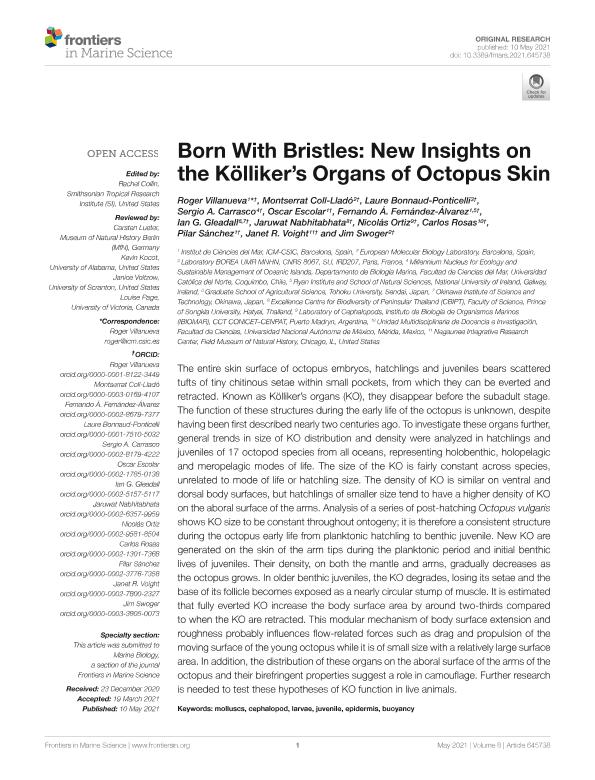Mostrar el registro sencillo del ítem
dc.contributor.author
Villanueva, Roger
dc.contributor.author
Coll Lladó, Montserrat
dc.contributor.author
Bonnaud-Ponticelli, Laure
dc.contributor.author
Carrasco, Sergio A.
dc.contributor.author
Escolar, Oscar
dc.contributor.author
Fernández Álvarez, Fernando Ángel

dc.contributor.author
Gledall, Ian G.
dc.contributor.author
Nabhitabhata, Jaruwat
dc.contributor.author
Ortiz, Nicolás

dc.contributor.author
Rosas, Carlos
dc.contributor.author
Sánchez, Pilar
dc.contributor.author
Voight, Janet R.
dc.contributor.author
Swoger, Jim
dc.date.available
2022-07-15T17:10:52Z
dc.date.issued
2021-03
dc.identifier.citation
Villanueva, Roger; Coll Lladó, Montserrat; Bonnaud-Ponticelli, Laure; Carrasco, Sergio A.; Escolar, Oscar; et al.; Born With Bristles: New Insights on the Kölliker’s Organs of Octopus Skin; Frontiers Media; Frontiers In Marine Science; 8; 645738; 3-2021; 1-19
dc.identifier.uri
http://hdl.handle.net/11336/162223
dc.description.abstract
The entire skin surface of octopus embryos, hatchlings and juveniles bears scattered tufts of tiny chitinous setae within small pockets, from which they can be everted and retracted. Known as Kölliker organs (KO), they disappear before the subadult stage. The function of these structures during the early life of the octopus is unknown, despite having been first described nearly two centuries ago. To investigate these organs further, general trends in size of KO in octopus, distribution and density were analysed in hatchlings and juveniles of 17 octopod species from all oceans, representing holobenthic, holopelagic and meropelagic modes of life. The size of the KO is fairly constant across species, unrelated to mode of life or hatchling size. The density of KO is similar on ventral and dorsal body surfaces, but hatchlings of smaller size tend to have a higher density of KO on the aboral surface of arms. Analysis of a series of post-hatching Octopus vulgaris shows KO size to be constant throughout ontogeny; it is therefore a consistent structure during the octopus early life from planktonic hatchling to benthic juvenile. New KO are generated on the skin of the arm tips during the planktonic period and initial benthic lives of juveniles. Their density, on both the mantle and arms, gradually decreases as the octopus grows. In older benthic juveniles, the KO degrades, losing its setae and the base of its follicle becomes exposed as a nearly circular stump of muscle. It is estimated that fully-everted KO increase the body surface area by around two-thirds compared to when the KO are retracted. This modular mechanism of body surface extension and roughness probably influences flow-related forces such as drag and propulsion of the moving surface of the young octopus while it is of small size with a relatively large surface area. In addition, the distribution of these organs on the aboral surface of the arms of the octopus and their birefringent properties suggest a role in camouflage. Further research is needed to test these hypotheses of KO function in live animals.
dc.format
application/pdf
dc.language.iso
eng
dc.publisher
Frontiers Media

dc.rights
info:eu-repo/semantics/openAccess
dc.rights.uri
https://creativecommons.org/licenses/by/2.5/ar/
dc.subject
MOLLUSCS
dc.subject
CEPHALOPODS
dc.subject
LARVAE
dc.subject
JUVENILE
dc.subject
EPIDERMIS
dc.subject
BOUYANCY
dc.subject
EMBRYOS
dc.subject
CAMOUFLAGE
dc.subject.classification
Biología Marina, Limnología

dc.subject.classification
Ciencias Biológicas

dc.subject.classification
CIENCIAS NATURALES Y EXACTAS

dc.subject.classification
Zoología, Ornitología, Entomología, Etología

dc.subject.classification
Ciencias Biológicas

dc.subject.classification
CIENCIAS NATURALES Y EXACTAS

dc.title
Born With Bristles: New Insights on the Kölliker’s Organs of Octopus Skin
dc.type
info:eu-repo/semantics/article
dc.type
info:ar-repo/semantics/artículo
dc.type
info:eu-repo/semantics/publishedVersion
dc.date.updated
2021-12-13T19:23:56Z
dc.identifier.eissn
2296-7745
dc.journal.volume
8
dc.journal.number
645738
dc.journal.pagination
1-19
dc.journal.pais
Suiza

dc.journal.ciudad
Lausana
dc.conicet.avisoEditorial
Copyright © 2021 Villanueva, Coll-Lladó, Bonnaud-Ponticelli, Carrasco, Escolar, Fernández-Álvarez, Gleadall, Nabhitabhata, Ortiz, Rosas, Sánchez, Voight and Swoger. This is an open-access article distributed under the terms of the Creative Commons Attribution License (CC BY). The use, distribution or reproduction in other forums is permitted, provided the original author(s) and the copyright owner(s) are credited and that the original publication in this journal is cited, in accordance with accepted academic practice. No use, distribution or reproduction is permitted which does not comply with these terms.
dc.description.fil
Fil: Villanueva, Roger. Consejo Superior de Investigaciones Científicas; España
dc.description.fil
Fil: Coll Lladó, Montserrat. European Molecular Biology Laboratory; España
dc.description.fil
Fil: Bonnaud-Ponticelli, Laure. Laboratory BOREA UMR MNHN; Francia
dc.description.fil
Fil: Carrasco, Sergio A.. Universidad Católica del Norte; Chile
dc.description.fil
Fil: Escolar, Oscar. Consejo Superior de Investigaciones Científicas; España
dc.description.fil
Fil: Fernández Álvarez, Fernando Ángel. National University of Ireland Galway; Irlanda
dc.description.fil
Fil: Gledall, Ian G.. Tohoku University; Japón. Okinawa Institute of Science and Technology; Japón
dc.description.fil
Fil: Nabhitabhata, Jaruwat. Prince Of Songkla University; Tailandia
dc.description.fil
Fil: Ortiz, Nicolás. Consejo Nacional de Investigaciones Científicas y Técnicas. Centro Científico Tecnológico Conicet - Centro Nacional Patagónico. Instituto de Biología de Organismos Marinos; Argentina
dc.description.fil
Fil: Rosas, Carlos. Universidad Nacional Autónoma de México; México
dc.description.fil
Fil: Sánchez, Pilar. Consejo Superior de Investigaciones Científicas; España
dc.description.fil
Fil: Voight, Janet R.. Field Museum of Natural History, Chicago; Estados Unidos
dc.description.fil
Fil: Swoger, Jim. European Molecular Biology Laboratory; España
dc.journal.title
Frontiers In Marine Science

dc.relation.alternativeid
info:eu-repo/semantics/altIdentifier/doi/https://doi.org/10.3389/fmars.2021.645738
dc.relation.alternativeid
info:eu-repo/semantics/altIdentifier/url/https://www.frontiersin.org/articles/10.3389/fmars.2021.645738/full
Archivos asociados
